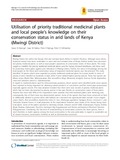| dc.description.abstract | Mwingi District lies within the Kenyan Arid and Semiarid lands (ASALs) in Eastern Province. Although some ethnobotanical surveys have been undertaken in some arid and semiarid areas of Kenya, limited studies have documented priority medicinal plants as well as local people's awareness of conservation needs of these plants. This study sought to establish the priority traditional medicinal plants used for human, livestock healthcare, and those used for protecting stored grains against pest infestation in Mwingi district. Further, the status of knowledge among the local people on the threat and conservation status of important medicinal species was documented. This study identified 18 species which were regarded as priority traditional medicinal plants for human health. In terms of priority, 8 were classified as moderate, 6 high, while 4 were ranked highest priority species. These four species are Albizia amara (Roxb.) Boiv. (Mimosacaeae), Aloe secundiflora (Engl. (Aloaceae), Acalypha fruticosa Forssk. (Euphorbiaceae) and Salvadora persica L. (Salvadoraceae). In regard to medicinal plants used for ethnoveterinary purposes, eleven species were identified while seven species were reported as being important for obtaining natural products or concoctions used for stored grain preservation especially against weevils. The data obtained revealed that there were new records of priority medicinal plants which had not been documented as priority species in the past. Results on conservation status of these plants showed that more than 80% of the respondents were unaware that wild medicinal plants were declining, and, consequently, few of them have any domesticated species. Some of the species that have been conserved on farm or deliberately allowed to persist when wild habitats are converted into agricultural lands include: Croton megalocarpus Hutch., Aloe secundiflora, Azadirachta indica A. Juss., Warburgia ugandensis Sprague, Ricinus communis L. and Terminalia brownie Fresen. A small proportion of the respondents however, were aware of the threats facing medicnal plants. Some of the plants reported as declining include, Solanum renschii Vatke (Solanaceae), Populus ilicifolia (Engl.) Rouleau (Salicaceae), Strychnos henningsii Gilg (Loganiaceae) and Rumex usambarensis (Dammer) Dammer (Polygonaceae). Considering the low level of understanding of conservation concerns for these species, there is need therefore, to build capacity among the local communities in this area particularly in regard to sustainable use of natural resources, conservation methods as well as domestication processes | en |

